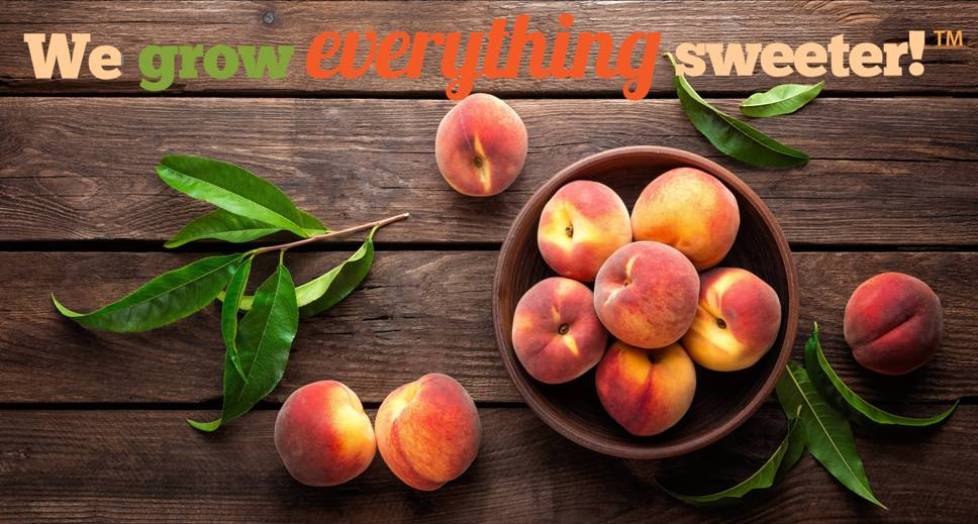We Put the Peach in Georgia
Have you ever wondered why peaches from Georgia are so good? It’s the flavor! A fresh, sweet Georgia peach is the most flavorful peach you can get anywhere. And that’s no accident. A lot of things have perfectly come together to give our peaches their one-of-a-kind legendary flavor including climate, soil, expertise and maybe just a little Peach County magic. After all, we put the Peach in Georgia.
The first Georgia peaches were shipped to the New York market between 1858 and 1860. They were transported by wagon to Augusta, then by shallow-draft boat to Savannah, and finally by steamship to New York. Georgia earned its "Peach State" designation during the three decades following the Civil War as Fort Valley and Peach County became the epicenter of the peach industry and the Peach Capital of the World.
As many as 18 peach packing houses lined the streets of Fort Valley in the heyday of the peach industry. Byron, the county’s only other city, located some 12 miles north on the rail line, had as many as 14. One local grower moved his house several thousand yards so he could watch his peaches being loaded into rail cars (that structure, the Troutman Home, currently houses the chamber and Fort Valley’s Main Street offices).
Today there are just two major growing and packing operations here, Lane Southern Orchards and Pearson's Big 6 Farm owned by two families who have lived and worked and farmed here for more than 130 years!
Fresh Georgia peaches are available only 16 weeks each year, from mid-May until August. Long known as the Peach State, Georgia produces, arguably, the sweetest and tastiest peaches grown anywhere. In 2016, the Georgia peach crop totaled 86.6 million pounds and brought in $46.3 million.
First grown in China almost 4,000 years ago, peaches have spread from their homeland to the western world via India and Persia where they were first cultivated. Peaches were later introduced into Europe and Columbus brought peach seeds to the new world on his second and third trips. These seeds eventually found their way to the red clay soil of middle Georgia where they were planted on acres of land which would later become Peach County.
Though peaches were originally planted in St. Augustine, Fla., Franciscan monks introduced them to St. Simons and Cumberland islands along Georgia's coast in 1571. By the mid-1700s peaches and plums were cultivated by the Cherokee Indians. Before the Civil War, increasing numbers of home orchards were planted in Georgia.
Raphael Moses, a planter and Confederate officer from Columbus, was among the first to market peaches within Georgia in 1851 and is credited with being the first to ship and sell peaches successfully outside of the South. His method of shipping peaches in champagne baskets, rather than in pulverized charcoal, helped to preserve the flavor of the fruit and contributed to his success.
Samuel Rumph, a Marshallville peach grower, perfected a new peach variety in 1870, which he named for his wife, Elberta. This yellow-fleshed peach was of superior quality and shipped better than previous varieties. Elberta remained the leading peach in Georgia until 1960, but newer varieties have since replaced the Elberta in commercial use. Although the Elberta remains the most famous peach name, Georgia now produces more than 40 commercial varieties ... and the Elberta is not one of them.
Rumph also pioneered improvements in rail transportation and the development of the refrigerated rail car which allowed rapid shipments to northern markets on a large scale.
Considerable expansion of peach acreage occurred in the late 19th and early 20th centuries, resulting in an all-time high production of almost eight million bushels by 1928. Since then production has decreased to about 1.7 million bushels annually.
Georgia enjoys important production and marketing advantages, primarily its proximity to eastern markets and favorable prices because of early harvests and high-quality fruit production.
Nearly all peaches grown in Georgia are sold in the wholesale fresh market, with a small percentage sold at roadside markets. There is no significant processing of peaches in Georgia.
Peach expansion in acreage and production was fueled by several factors. The abolition of slavery forced farmers to search for alternatives to the traditional labor-intensive cotton crop. Peaches, in particular, benefited from this transition.
The Georgia State Horticultural Society, founded near Augusta in 1876, promoted the introduction and testing of many fruit varieties and their distribution throughout the state while under the leadership of Prosper J.A. Berckmans, a nurseryman and pomologist. The old Fruitlands Nursery is now the site of the Augusta National Golf Club, home to the annual Masters Tournament.
Berckmans became famous for introducing new fruit varieties that were more suitable for growing in southern climates. He developed or improved many types of peaches and eventually became known as the "Father of Peach Culture" across the South. Among his varieties were the South Chinese (or Honey) peach and the Chinese Cling. From the Chinese Cling, Prosper eventually bred the Elberta, Belle and Thurber peaches, which became Georgia's primary commercial varieties. His Thurber peach was the leading variety until it was replaced by the Elberta.
Georgia's peach industry is concentrated in Peach, Crawford, Taylor and Macon counties along the fall line, the transition zone between Georgia's Piedmont and Coastal Plain. This area is far enough north to receive sufficient winter chilling, but far enough south to avoid late frosts and guarantee early harvest dates. The early harvest allows premium prices for the crop. Additionally, the sandy loam soils of the fall line are more favorable to peach production than the Piedmont's heavy clays or the Coastal Plain's sands.
Big 6 Farm
Five generations of the Pearson family have farmed the red Georgia clay in this area for more than 130 years. The Pearson family's Big 6 Farm is comprised of 1,500 acres of peaches and 2,000 acres of pecans. This family farm produces a bounty of fruit and nuts with the finest being used in Mary Pearson's online e-commerce business, Pearson Farms.
It all started in 1885 when Moses Winlock (Lockie) Pearson and his wife, Emma, moved to middle Georgia and planted their own family roots and the first peach trees for the Pearson family. They eventually had six sons and six daughters. One of their sons, John, current managing partner Al Pearson's grandfather, started farming on his own, adding more land to the family holdings and planting more peaches.
Lawton, the youngest son of John and Rosa Lee Pearson, and his wife Laurie began to work with the family farm in Zenith and they had three children: Peggy, Ann and Al. As children, the Pearson children all worked in the peach packing shed every summer where lessons in perseverance and tenacity were learned. No matter how tired or how late the hour, peaches must be ready for timely shipping to New York and other points north.
After college, Al joined his father in farming. In 1972, he married Mary McLennan whom he met at the University of Georgia and they also have three children – Mary Katherine, Lawton and Laurie. In 1973 Al began operating the farm as Big 6 Farm, a partnership effort owned by Al and his two sisters, farming together for 35 years. Al and his son Lawton, a recent law school graduate, purchased the business in 2008 and began farming together. Lawton married Lanier Defnall and they now have three young children – Adeline, Cort and Sutton. Al and Lawton also grow a large acreage of pecans.
Big 6 Farm has met the food safety standards and Good Agriculture Practices (GAP) guidelines set by the USDA and the FDA. Big 6 has also met the audit standards established under the Georgia GP Food Safety Programs. It is one of only three farms in Georgia to earn this designation and the only peach and pecan farm.
Visit the Pearson Farm/Big 6 website for more information.
Lane Southern Orchards
Founded in 1908 by John David Duke as Diamond Fruit Farm, Lane Packing Co. farms more than 6,000 acres of peaches and pecans. Located just outside of Fort Valley, the fourth-generation family operation now grows more than 35 varieties of peaches.
John David Duke built his first peach packing house in 1942. J.D, Duke Packing Co. was taken over by his son-in-law David O. Lane, and grandson, Duke Lane Sr. in 1950 and the packing shed became known as Lane Packing Co.
Following the retirement of his father, Duke Lane Sr. became sole owner and, until 1975, continued to pack peaches at the same location his grandfather built in 1942.
In 1976, Duke Lane Sr. formed a partnership with the Russell Pearson family. Together they built a more modern packing house and named the company Pearson & Lane. This partnership remained in place until 1989. After the 1989 season, the Lane family began construction of a new packing house on the family farm. This facility is one of the most modern of its kind and was ready just in time for the 1990 crop.
With the new packing house built, Duke Lane Sr. turned the business over to his four children -- the late Ann Rigdon, Duke Jr., Bobby, Steve -- who continue to run it today.
Visit the Lane Packing Co. website for more information.
(Information for this article taken from histories provided by the Lane family and Al Pearson as well as information from an article written by Kathryn C. Taylor at the University of Georgia.)

